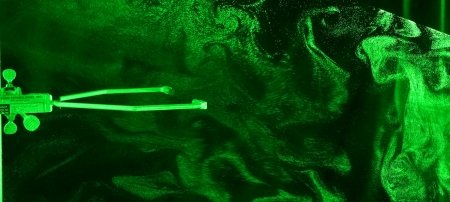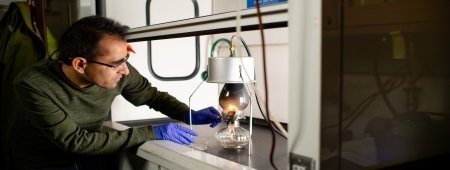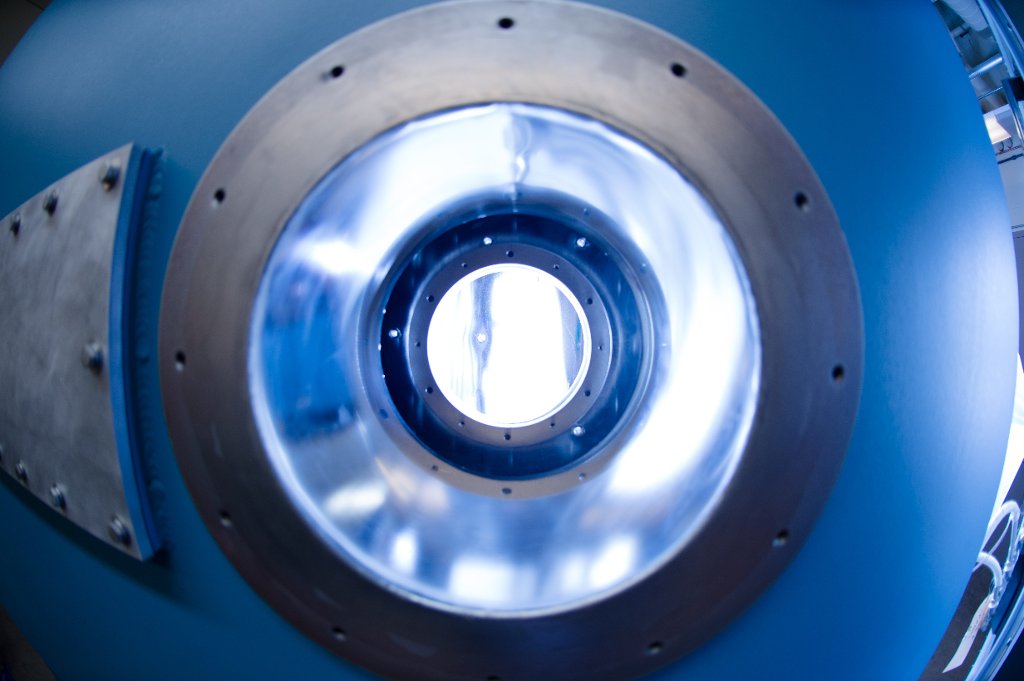Faculty and students in the Atmospheric Sciences program at Michigan Tech undertake research about air currents, clouds, volcanic emissions, snow, and more.
Why is it that sometimes clouds form but not a drop of rain falls? How can we better understand environmental processes at a molecular level? How do air currents transport air pollution and what are the effects?
These are some of the questions students and faculty in the Atmospheric Sciences doctoral program have sought to answer. These questions have led researchers to seek answers as far away as Pico Mountain in the Azores, a Portuguese archipelago in the northern Atlantic Ocean, and as near as the Keweenaw Waterway.
The interdisciplinary program that boasts faculty from physics, geological and mining engineering, chemistry, forestry and civil and environmental engineering is celebrating the 10th anniversary of its founding this year.
Condensing diverse fields into an interdisciplinary program
Much like condensation nuclei—a particle of dust or pollen on which water vapor condenses to form a cloud—the idea to create the Atmospheric Sciences program was formed around the idea that students would be more likely to come to Michigan Technological University to study questions of the atmosphere and its effects on society if there was a formal graduate field of study. The program needn’t be housed within one department, but rather could benefit from the expertise of diverse faculty.
Richard Honrath, who was a professor in the geological and mining engineering and sciences department, founded the program prior to his death in 2009. Additionally, he established the Pico Mountain Observatory atop a volcanic caldera where 10 years of data on trace gases and air pollution in the atmosphere have been gathered.
The complexities of the atmosphere require that it is studied from multiple vantage points; confining study of the atmosphere into one discipline is impossible. The program at Michigan Tech, then, is rooted in diverse areas of physics and chemistry, drawing on fluid dynamics, thermodynamics, kinetic theory, physical chemistry and even biology.
"Atmospheric scientists work on problems as varied as climate, dispersion of pollutants and weather forecasting. A lot of our students feel like working in this field will allow them to do something that has a real chance for improving the condition of the human family."
Atmospheric sciences programs can have micro or macro foci, and the myriad options for research point to the depth and breadth of the field. Broadly defined, atmospheric sciences is the study of the atmosphere. This includes inclement weather—storm fronts, hurricanes, tornadoes. It includes cloud microphysics, the study of individual cloud droplets and the precursors to clouds: aerosol particles and water vapor. Researchers in the discipline study lake effect snow and ice formation. Atmospheric sciences also includes atmospheric chemistry, which examines how aerosols and ozone are formed and how particulate matter interacts within chemicals in the atmosphere.
“The most important impact (the program) has had is to instill a sense of community and collaboration in the atmospheric sciences here” says Will Cantrell, professor of physics. “It has strengthened the collaborative ties and has certainly helped our students. Now our students are interacting with other students in atmospheric sciences. They get different perspectives. They have a bigger and better context to put their own research into.”
To date, eight students have graduated from the PhD program. The first graduate of the program, Matthew Beals, now works as technical staff at the MIT Lincoln Laboratory. His research at Michigan Tech focused on how clouds mix at their edges, and the implication that has on the size and density of drops falling from the clouds after mixing. This has advanced understanding of how precipitation forms in climate modeling.
Beals did this work using an instrument known as the holographic detector for clouds (HOLODEC). The HOLODEC records 3D images of air and the particles within those small volumes while attached to the wing of a research airplane. Analyzing the data showed Beals the structure of drops in the clouds in the process of mixing, which took Beals’ research from theoretical to actual during airplane rides in the clouds above Wyoming and Colorado.
Beals says that the hands-on experimental focus of the program is what attracted him to Michigan Tech.
“My research involved not only analyzing and interpreting data, but designing, building and operating the equipment required to collect the data,” he says.
"There was always an opportunity to be in the lab or in the field. Participating in research campaigns with some of the best scientists in the field was quite an experience, as was getting to fly with the instrument on the missions."
Noopur Sharma, another graduate of the program, is now employed at the Environmental Molecular Science Laboratory at the Pacific Northwest National Laboratory. While at Michigan Tech, Sharma studied atmospheric particles, also known as aerosols. The shapes, sizes and mixing states influence how much the particles absorb or scatter solar radiation. Sharma says the focus of her research was to investigate the aerosol shape, sizes and mixing states, and how the absorption and scattering of light by aerosols is affected by these parameters.
“Great mentors and unique facilities like the cloud chamber made learning and research very enjoyable,” she says. “The best part of (the atmospheric sciences program) is that it is a multi-disciplinary program, where interaction between different research groups and departments are encouraged.”
She noted that the Earth, Planetary and Space Sciences Institute seminar series, which brings eminent scientists from atmospheric sciences to Tech to share their research helped her keep pace with the ongoing research, as well as the opportunity to go to lunch with the speaker, providing a more intimate chance to learn from the experiences that speakers shared.
“My involvement in collaborative projects and field and laboratory campaigns gave me a chance to interact with people, make contacts, learn efficiently and gain confidence in research,” she says.
At its core, the atmospheric sciences program is about gaining an understanding of the atmosphere and the processes that occur within it, whether biogenic or anthropogenic.
“Humans tend to be interested in the lower part of the atmosphere because that’s where we live,” says Judith Perlinger, professor of civil and environmental engineering. She noted that the major fields of study in atmospheric sciences often center around pollutants trapped in this lower part of the atmosphere.
Faculty hope that students will come away from the program motivated to lessen anthropogenic impacts to the atmosphere, and with the skills to help society better understand the air around us.
“I'm convinced that, in the long run, better science is the result of this all having happened organically, from the bottom up. Science cannot be managed, it has to be nurtured,” Shaw says. “I think we all hope that Michigan Tech will continue to grow in its reputation for being a strong center of atmospheric sciences research, and that our students and alumni will continue to move out into the world and make contributions that are a result, in part, of having been a part of this program.”
Shaw said that program faculty are grateful to department chairs, deans and administrators who have helped nurture the program over the years.
On the horizon
The future of the program at Michigan Tech is largely dictated by the research interests of the faculty and students. Cloud formation, molecular-level environmental processes, volcanic emissions, air pollution, coupled ocean-atmosphere models and snow are current foci. Students navigating through coursework and research can rest assured their training will be as interdisciplinary as the careers they can look forward to.
“Atmospheric scientists need many skills,” says Lynn Mazzoleni, associate professor of chemistry. “They need to have some field experience. They need to build skills for collaboration, like learning how to speak to people from another country or discipline. In addition, they need laboratory skills and writing skills.”
There is no one discipline from which to approach atmospheric sciences; there’s a future with many possible directions for the program.
“There isn’t really one definition of what atmospheric science is,” Mazzoleni says. “That means there’s a lot of room for growth.”
Michigan Technological University is an R1 public research university founded in 1885 in Houghton, and is home to nearly 7,500 students from more than 60 countries around the world. Consistently ranked among the best universities in the country for return on investment, Michigan's flagship technological university offers more than 120 undergraduate and graduate degree programs in science and technology, engineering, computing, forestry, business, health professions, humanities, mathematics, social sciences, and the arts. The rural campus is situated just miles from Lake Superior in Michigan's Upper Peninsula, offering year-round opportunities for outdoor adventure.







Comments